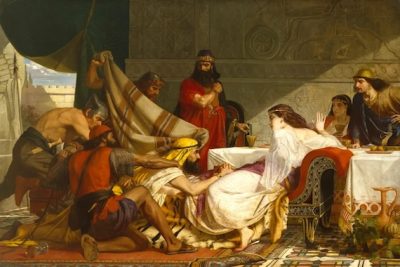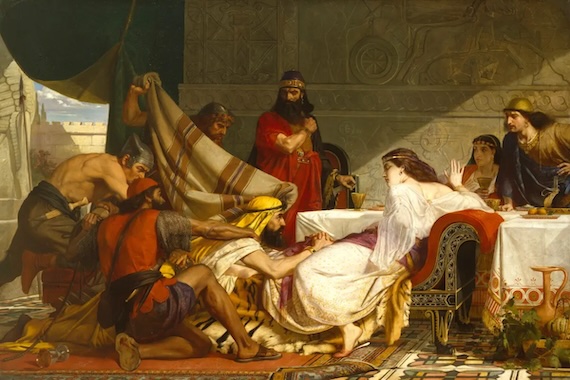Jewish Holiday of Purim at the Time of Genocide
The Jewish holiday of Purim, related in the Book of Esther, celebrates deliverance from a genocide.

All Global Research articles can be read in 51 languages by activating the Translate Website button below the author’s name (only available in desktop version).
To receive Global Research’s Daily Newsletter (selected articles), click here.
Click the share button above to email/forward this article to your friends and colleagues. Follow us on Instagram and Twitter and subscribe to our Telegram Channel. Feel free to repost and share widely Global Research articles.
Global Research Fundraising: Stop the Pentagon’s Ides of March
***
The Jewish holiday of Purim, related in the Book of Esther, celebrates deliverance from a genocide.
How to celebrate it when death and starvation kill thousands in Gaza, and the holiday’s rhetoric, namely the memory of the archenemy Amalek, is being used by Israeli politicians responsible for it?
Jewish tradition as shaped by Rabbinic Judaism abhors literal reading of the Torah all the while considering it the holiest object in existence. This, in fact, is what distinguishes the Jews from the Karaims, who remain attached to literalism. One may offer different reasons for the rabbis’ insistence on interpreting biblical verses. They consider the text timeless, so in order to make it meaningful for future generations they must explain and decode it. This dynamic view of the eternal is reflected in the very term used for Judaic law, the halakha, which is derived from the root “move.” It may well be that rabbis felt uneasy with the literal reading and so offered their own understanding of a biblical verse. This approach rejects anachronism and fundamentalism and tries to make the Torah a living source of inspiration.
Violence is not rare in biblical texts. The Pentateuch and several of the books of the prophets, such as Joshua and Judges, teem with violent images. From the genocidal command to wipe out seven nations inhabiting the Promised Land to the obligation to blot out the memory of Amalek, there are quite a few episodes that appear to promote massacre. Biblical Israel was conquered under conditions that could hardly be described as peaceful.
But far from glorifying war, Jewish tradition decisively deemphasizes military prowess as the principal reason for the victories mentioned in the Bible. After the Romans’ destruction of the Second Temple of Jerusalem, Jewish life underwent a transformation. Viewed in the context of Judaism, the annihilation of Jerusalem defined the normative attitude toward force, resistance, and the Land of Israel for nearly two millennia.
Rather than promote revenge, Jewish tradition encourages self-examination. After a calamity or a misfortune occurs, one is advised to examine and correct one’s own misdeeds (lefashpesh bemaasaw). This approach suggests that the Temple was razed by the Romans because of gratuitous hatred among the Jews, and that the first exile to Babylonia occurred because of illicit sex, murder, and idolatry.
The Roman siege of Jerusalem in the first century, like the Israeli siege of Gaza, sharply divided the Jews.
The scholars of the Law tended to favor negotiated compromise, while the zealots organized a forceful response. Classical exegetes — such as the Italian Ovadia Seforno (1470–1550) — condemned the advocates of armed struggle in particularly severe terms: “If the Zealots had heeded Rabbi Yohanan Ben Zakkai [a prominent scholar opposed to violence], the Temple of Jerusalem would not be destroyed.” Considering the central position held by the Temple in Judaism, the accusation is indeed serious and serves as a warning against any collective temptation to use force. The Mishna defines a strong man as someone who succeeds in controlling his own inclinations, passions, and urges (Pirke Avot, 4:1).
But what does Jewish tradition do with explicit violence mentioned in the Torah? The oral tradition interprets it allegorically: the sword and the bow used by Jacob the Patriarch against his enemies (Genesis 48:22) become prayer and supplication (Bereshit Rabbah 97:6); the victory of Benaiah over Moab (2 Samuel 23:20) now stands for Torah study (Babylonian Talmud, Berakhot, 18b).
To some, Purim provides a model for conflict resolution. The story is as simple as it is prophetic. Haman, the Persian vizier, has planned a total massacre: “to destroy, to kill, and to annihilate, all Jews, both young and old, little children and women, in one day” (Esther 3:13). The response of the Jews was to proclaim a fast of repentance, but at the same time to find a way to influence the king and thereby circumvent the vizier and his decree. Queen Esther intervened, revealed to the king her Jewish origins, and convinced him to stop the planned genocide. “But it did not occur to any of the Jews to use physical means against Haman,” noted Rabbi Elhanan Wasserman in his commentary on the history of Purim written at the end of the 1930s (Jewish Guardian 1977, 8–9). Yet, the massacre of 75 000 people at the hand of the Jews that is mentioned in the final chapter, albeit explicitly authorized by the king, causes anguish and calls for interpretation.

Edward Armitage, “The Festival of Esther,” 1865, Royal Academy of Arts 03/1188
One such initiative was undertaken by the Shalom Center in Philadelphia. A range of people wrote their own versions of the final chapter. Many were inspired by classical Judaic sources aware that violence can only beget more violence and cycles of revenge. One commentary suggests that Jews offered gifts of food to their erstwhile enemies, which dovetails with the Purim custom of mishloah manot, sending each other edible items. Moreover, such behavior would be considered heroic. Avot de Rabbi Nathan, an 8th century source, defines a hero as someone who can turn an enemy into a friend (23:1).
Yet, quite a few followers of National Judaism (or, in Hebrew, dati-leumi), including members of the current Israeli government, revere a different kind of a hero. They erected a shrine to commemorate Dr Baruch Goldstein (1956–1994), a US-born physician, who massacred dozens of Muslims praying in Hebron on the day of Purim. He had apparently been influenced by the biblical readings associated with Purim, calling for the extermination of Amalek. He saw Amalek in Muslims and Palestinians, which inspired his murderous mission.
The association of the Palestinians with Amalek seems to have become so common in Israel that it encourages unbridled cruelty from IDF soldiers sent to Gaza. They chant with joy about how they are destroying Amalek. The direct link between the biblical texts and the challenges facing Israel encourages violence as has been graphically shown at the International Court of Justice in The Hague in January 2024.
Jews have long associated their enemies with Amalek. Among others, Zionists have been often portrayed as Amalekites by those Jews who oppose the Zionist colonization of Palestine. But they would never resort to violence in their struggle against the modern Amalek. Rather, some rabbis called on the faithful to resist the internal Amalek and fight off the emotion, in rabbinical parlance, the evil inclination (yetser har’a), which tempts some Jews to identify with Zionism and the state that embodies this ideology. The numerical value (gematria) of the letters constituting Amalek is equal to that of the letters in the word safeq, doubt. These rabbis argue that rejection of Zionism should brook no doubt.
Zionist settlement in Palestine and the unilateral declaration of independence by the state of Israel in 1948 challenged the tradition of non-literalism, certainly among the secularized settlers but only slightly less among those affiliated with National Judaism. From the beginning, Zionism has encouraged love of the land, a love that has taken political and ideological forms. The nature hikes with the Torah in the hand have been intended to impart an intimate knowledge of the terrain mentioned in biblical verses. This organic intimacy breeds literal rapport with the Torah recounting events that are believed to have happened mostly in that land.
But the events narrated in the Book of Esther are located elsewhere. Against the continuing massacres and starvation of Palestinians in Gaza we can celebrate Purim by transforming the violence it contains into a manifestation of empathy. We can write our own finales for the Book of Esther. After all, Purim is a holiday of radical transformation. Haman thought he would be the one to be honored by the king, but it was his worst enemy, Mordechai, whom Haman was forced to praise and parade. Jews were facing a genocide, but then the tables turned, transforming a day of anguish into festivity. The Torah is eternal precisely because it is not immutable and allows for time-sensitive interpretations, including those of the Book of Esther.
*
Note to readers: Please click the share button above. Follow us on Instagram and Twitter and subscribe to our Telegram Channel. Feel free to repost and share widely Global Research articles.
Yakov M. Rabkin is Professor Emeritus of History at the Université of Montréal. His publications include over 300 articles and a few books: Science between Superpowers, A Threat from Within: a Century of Jewish Opposition to Zionism, What is Modern Israel?, Demodernization: A Future in the Past and Judaïsme, islam et modernité. He did consulting work for, inter alia, OECD, NATO, UNESCO and the World Bank. E-mail: [email protected]. Website: www.yakovrabkin.ca

